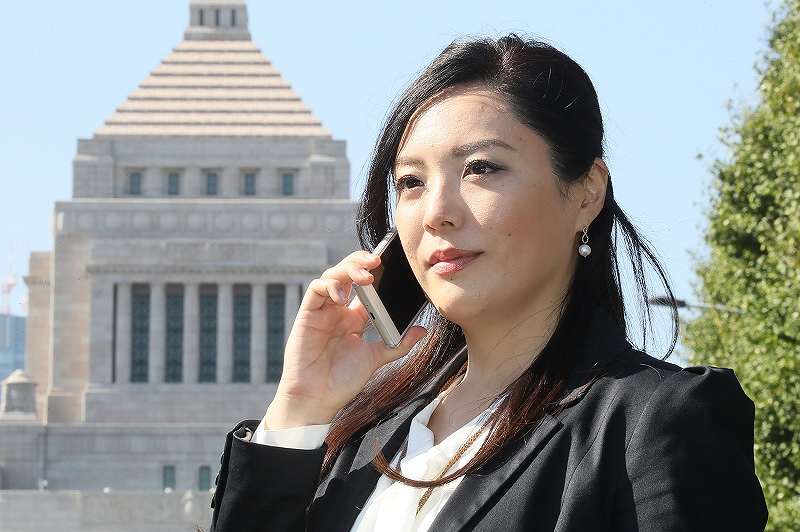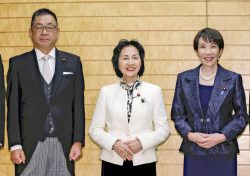Japan’s Sakishima Islands at Risk in Tense Region; Civil Defense Preparations Underway in Yonaguni

An evacuation drill is held in February in Ishigaki, Okinawa Prefecture.
8:00 JST, May 18, 2024
It is natural for parents to try to explain things to their children as easily as possible. In my case, when teaching my children about social studies, it may be part of my professional nature as a newspaper reporter to explain issues by incorporating current events.
“What is the westernmost island of Japan, located at 24 degrees north?”
“It’s Yonaguni Island.”
“Correct. You know what, Yonaguni Island has a very important meaning for Japan. That’s because Taiwan is only 100 kilometers away …”
Yonaguni Island will be Japan’s front line in the event of an emergency in Taiwan. Since his inauguration in 2013, Chinese President Xi Jinping, who has advocated the “great rejuvenation of the Chinese nation,” has pushed forward with military expansion without hiding his ambition for unification with Taiwan. China’s defense spending is now three to four times that of Japan’s.
In February this year, the U.S. government published the annual threat assessment of the Office of the Director of National Intelligence, which analyzes global threats. It warns that “the People’s Republic of China (PRC) will press Taiwan on unification, an effort that will create critical friction points with the United States.” It also emphasizes the importance of Taiwan, calling it “a significant potential flashpoint for confrontation between the PRC and the United States as Beijing claims that the United States is using Taiwan to undermine China’s rise.”
If a Taiwan emergency occurs, it will inevitably have an impact on the Sakishima Islands of Okinawa Prefecture, including Yonaguni Island, which are geographically close to Taiwan. There is a risk that China could carry out a missile attack or airstrike and Japanese aircraft could be hit. Also, if either Taiwan or China were to lay mines in the sea, some of them could drift into waters near Japan, making it impossible for ships to navigate. In the worst-case scenario, China could attack U.S. military bases in Japan in order to prevent the dispatch of U.S. forces, leading to an “armed attack situation” that could lead to hostilities between Japan and China.
Furthermore, in addition to China-Taiwan tensions, North Korea is proceeding with its development of nuclear weapons and missiles. It already possesses a considerable number of nuclear warheads, and there are noticeable signs that its missile technology is becoming more sophisticated.
In light of the security environment in East Asia, Prime Minister Fumio Kishida has repeatedly expressed a sense of crisis in meetings with leaders of other countries and at international conferences, comparing Russia’s invasion of Ukraine with the geopolitical hazards facing Japan. In his speech to the U.S. Congress in April, he called for closer cooperation between Japan and the United States, saying, “Today’s Ukraine may be tomorrow’s East Asia.”
As this situation in East Asia becomes the norm, another new element has been added to my explanation to my children concerning Yonaguni Island during this spring holiday.
“Japan has decided to construct civil defense shelters in the Sakishima Islands, including Yonaguni Island.”
Based on the Civil Protection Act, the Japanese government has compiled basic policies and guidelines for the five municipalities of the Sakishima Islands to develop shelters for residents to evacuate to in the event of an emergency. The government plans to provide financial support to municipalities that build robust underground shelters beneath existing public facilities. The plan is to stock them with enough food for about two weeks and provide communication equipment.
Members of the Yonaguni Town Council welcomed the government’s decision to build shelters, with one saying: “Since Yonaguni Island is a small island, there are few buildings with underground facilities. In preparation for unpredictable situations such as a Taiwan emergency, shelter construction is essential.”
The existence of shelters has been in the spotlight due to Russia’s invasion of Ukraine. Finland, which has a long border with Russia and has been exposed to threats from its larger neighbor, has been building nuclear shelters since the 1940s. According to Finland’s Interior Ministry, the country has 50,500 civil defense shelters with space for a total of 4.8 million people. Most of these shelters are used as car parks or subway stations during normal times.
In Ukraine, shelters have actually been used since the beginning of the invasion by Russia. Also in Israel, which was recently attacked by Iran, it has been reported that many citizens fled to shelters after receiving an air raid warning.
In Ukraine, where the fighting drags on, shelters are used on a daily basis to protect people’s lives. According to UNICEF, children in cities in Ukraine’s frontline areas such as the Zaporizhzhia and Donetsk regions have been forced to spend between 3,000 and 5,000 hours — the equivalent of four to seven months — of the past two years sheltering in cold, damp basements and underground metro stations, as air raid alerts sound above.
UNICEF Executive Director Catherine Russell said in February: “Every siren and explosion bring further anxiety. The war in Ukraine has shattered childhoods and wreaked havoc on children’s mental health and ability to learn.”
In Japan, even imagining an emergency has been taboo. Okinawa Gov. Denny Tamaki has said, “Peacebuilding through dialogue is necessary.” Unlike the Yonaguni town councilors, he is cautious about constructing shelters. However, if the government fails to prepare for a crisis, it will be unable to protect people’s lives. In the current situation, it seems inevitable for Japan to build shelters and strengthen its defense capabilities from the perspective of protecting its citizens. In conjunction with this, it is also essential to “strengthen diplomacy,” as called for in the section on strategic approaches in Japan’s National Security Strategy.
“Today’s East Asia has become yesterday’s Ukraine at last.”
This is the last thing we want to teach our children in the future.
Political Pulse appears every Saturday.

Yukiko Ishikawa
Yukiko Ishikawa is a staff writer in the Political News Department of The Yomiuri Shimbun.
"Editorial & Columns" POPULAR ARTICLE
-

Violations of Subcontract Law: Major Automakers Must Eliminate Old Practices
-

Local Governments’ Tax Revenues: Devise Ways to Correct Imbalances in Tax Sources
-

5 Japanese Business Dinner Mistakes to Avoid — and What They Taught Me About Business in Japan
-

Heavy Rains in Asia: Support for Victims, Flood-Control Measures Urgently Needed
-

New Nuclear Threat: China Seeking to Follow U.S., Russia in Military Expansion
JN ACCESS RANKING
-

Keidanren Chairman Yoshinobu Tsutsui Visits Kashiwazaki-Kariwa Nuclear Power Plant; Inspects New Emergency Safety System
-

Imports of Rare Earths from China Facing Delays, May Be Caused by Deterioration of Japan-China Relations
-

University of Tokyo Professor Discusses Japanese Economic Security in Interview Ahead of Forum
-

Japan Pulls out of Vietnam Nuclear Project, Complicating Hanoi’s Power Plans
-

Govt Aims to Expand NISA Program Lineup, Abolish Age Restriction

























